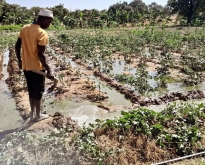The long dry season—from November to April every year—used to be a hardship for the village of Kunkua in the Bolgatanga-East District of Ghana. But now, a solar-powered water system has transformed their fortunes in a remarkable way.
Catastrophic climate change
The northern region of Ghana is believed to be one of the most vulnerable to climate change. Longer and more frequent periods of drought have spelt disaster for the Tele-Bere cooperative, which depends on rainfall to grow its crops and water its livestock. Crop failure and food shortages have been a reality for its 5,500 members, 85% of whom are women.
Water, especially during the dry season, was virtually non-existent, and farmers had to travel long distances with their livestock to drink at dams in neighbouring communities. As a result of the drought, young farmers were leaving their homes and migrating to cities in the south of the country in search of other jobs to earn money.
Although solar technology has become more affordable in recent years, the cost still prevents many farmers from installing irrigation systems, with micro-finance organizations and banks unwilling to take the risk of providing loans.
Here comes the sun
But thanks to a solar-powered water system installed in 2023 through the support of FFF, things have changed dramatically. Harnessing the sun’s power, the local farmers have turned the situation on its head. Their enemy is now their friend, allowing them to produce a year-round water supply.
So how does it work? The solar-powered system drives a mechanized borehole that irrigates an area of up to 6 hectares. First, a hole is drilled deep into the ground to access the water below, and a steel casing is installed to prevent the hole from collapsing. A borehole pumping system makes extracting natural water directly from the ground possible. Six solar panels convert the sun’s rays into electricity to power the pumping system, and every day, it produces 36,000 litres of life-changing water.
It means farmers can grow their crops—including tomatoes, amaranthus, okra, sweet potatoes, chilli peppers, cassava, bananas, cashews, maize, and millet—all year round. Their livestock, too, is thriving once more.
“We no longer trek for hours in search of water. It’s right here, within our reach. This project is a blessing, a game-changer,” says Ateni Azia, farmer and head of the Anongtaaba Women’s VSlA group under Tele-Bere.
Not only does solar irrigation provide farmers with an increased and more stable year-round income, but it also improves the nutrition of their families, as they are able to produce food crops throughout the year.
From drought to raising fish
The transformation has been remarkable. Most community members are now able to stay and engage in agricultural activities in the long dry season, and there has been a marked reduction in outmigration from the village.
And that’s not all. Because of the abundance of water throughout the year, some villagers in the community garden at Kunkua are even undertaking aquaculture to boost their income, raising freshwater fish, including tilapia and catfish.
Looking to the future, Tele-Bere’s major challenges remain the growing impact of climate change and increasingly erratic rainfall. Their priorities are to adopt greener sources of energy, especially solar water systems, and to increase the use of agroforestry practices to restore nature.
Article from FAO Ghana

